Java
From Wikipedia, the free encyclopedia
This article is about the Indonesian island. For the programming language, see Java (programming language). For other uses, see Java (disambiguation).
| Native name: Jawa-ꦗꦮ | |
|---|---|
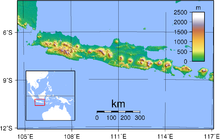
Topography of Java
|
|
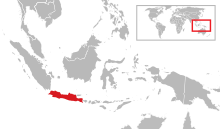 |
|
| Geography | |
| Location | Southeast Asia |
| Coordinates | 7°29′30″S 110°00′16″ECoordinates: 7°29′30″S 110°00′16″E |
| Archipelago | Greater Sunda Islands |
| Area | 138,794 km2 (53,589 sq mi) |
| Area rank | 13th |
| Highest elevation | 3,676 m (12,060 ft) |
| Highest point | Semeru |
| Country | |
| Provinces | Banten, Special Capital Region of Jakarta, West Java, Central Java, East Java, Yogyakarta Special Region |
| Largest city | Jakarta |
| Demographics | |
| Population | 143 million (as of 2014) |
| Density | 1,117 /km2 (2,893 /sq mi) |
| Ethnic groups | Javanese (inc. Cirebonese, Tenggerese, Osing) , Sundanese (inc. Bantenese, Baduy), Betawi, Madurese |
| Part of a series on |
| Religion at Java |
|---|
 |
Formed mostly as the result of volcanic eruptions, Java is the 13th largest island in the world and the fifth largest island in Indonesia. A chain of volcanic mountains forms an east-west spine along the island. It has three main languages, with Javanese being the dominant language; it is the native language of about 60 million people in Indonesia, most of whom live on Java. Most of its residents are bilingual, with Indonesian as their first or second languages. While the majority of the people of Java are Muslim, Java has a diverse mixture of religious beliefs, ethnicities, and cultures.
Java is divided into four provinces, West Java, Central Java, East Java, and Banten, and also two special regions, Jakarta and Yogyakarta.
Contents
Etymology
The origins of the name "Java" are not clear. One possibility is that the island was named after the jáwa-wut plant, which was said to be common in the island during the time, and that prior to Indianization the island had different names.[1] There are other possible sources: the word jaú and its variations mean "beyond" or "distant".[2] And, in Sanskrit yava means barley, a plant for which the island was famous.[2] "Yawadvipa" is mentioned in India's earliest epic, the Ramayana. Sugriva, the chief of Rama's army dispatched his men to Yawadvipa, the island of Java, in search of Sita.[3] It was hence referred to in Indian by the Sanskrit name "yāvaka dvīpa" (dvīpa = island). Another source states that the "Java" word is derived from a Proto-Austronesian root word, meaning 'home'.[4]Geography
See also: Volcanoes of Java
Java lies between Sumatra to the west and Bali to the east. Borneo lies to the north and Christmas Island is to the south. It is the world's 13th largest island. Java is surrounded by Java Sea in the north, Sunda Strait in the west, Indian Ocean in the south and Bali Strait and Madura Strait in the east.Java is almost entirely of volcanic origin; it contains thirty-eight mountains forming an east-west spine which have at one time or another been active volcanoes. The highest volcano in Java is Mount Semeru (3,676 m). The most active volcano in Java and also in Indonesia is Mount Merapi (2,930 m). See Volcanoes of Java.
More mountains and highlands help to split the interior into a series of relatively isolated regions suitable for wet-rice cultivation; the rice lands of Java are among the richest in the world.[5] Java was the first place where Indonesian coffee was grown, starting in 1699. Today, Coffea arabica is grown on the Ijen Plateau by small-holders and larger plantations.
The average temperature ranges from 22°C to 29°C; average humidity is 75%. The northern coastal plains are normally hotter, averaging 34°C during the day in the dry season. The south coast is generally cooler than the north, and highland areas inland are even cooler.[8] The wet season begins in October and ends in April during which rain falls mostly in the afternoons and intermittently during other parts of the year. The wettest months are January and February.
West Java is wetter than East Java and mountainous regions receive much higher rainfall. The Parahyangan highlands of West Java receive over 4,000 mm annually, while the north coast of East Java receives 900 mm annually.
Natural environment

Male Javan rhino shot in 1934 in West Java. Today only small numbers of Javan rhino survive in Ujung Kulon; it is the world's rarest rhino.
Originally Javan wildlife supported a rich biodiversity, where numbers of endemic species of flora and fauna flourished; such as the Javan rhinoceros,[9] Javan banteng, Java warty pig, Javan hawk-eagle, Javan peafowl, Javan silvery gibbon, Javan lutung, Java mouse-deer, Javan rusa, and Javan leopard. With over 450 species of birds and 37 endemic species, Java is a birdwatcher's paradise.[10] There are about 130 freshwater fish species in Java.[11]
However, Java is also home to large numbers of humans. With an estimated population of 114,733,500 in 1995, Java contains well over half of Indonesia's population.[12] Since ancient times, people have opened the rainforest, altered the ecosystem, shaped the landscapes and created rice paddy and terraces to support the growing population. Javan rice terraces have existed for more than a millennium, and had supported ancient agricultural kingdoms. The growing human population has put severe pressure on Java's wildlife, as rainforests were diminished and confined to highland slopes or isolated peninsulas. Some of Java's endemic species are now critically endangered, with some already extinct; Java used to have its own endemic tiger subspecies that went extinct in the mid-1970s. Today, several national parks exist in Java that protect the remnants of its fragile wildlife, such as Ujung Kulon, Mount Halimun-Salak, Gede Pangrango, Baluran, Meru Betiri and Alas Purwo.
Administrative division
The island is administratively divided into four provinces:- Banten, capital: Serang
- West Java, capital: Bandung
- Central Java, capital: Semarang
- East Java, capital: Surabaya
History

Mount Merbabu surrounded by rice fields. Java's volcanic topography and rich agricultural lands are the fundamental factors in its history.
The island's exceptional fertility and rainfall allowed the development of wet-field rice cultivation, which required sophisticated levels of cooperation between villages. Out of these village alliances, small kingdoms developed. The chain of volcanic mountains and associated highlands running the length of Java kept its interior regions and peoples separate and relatively isolated.[14] Before the advent of Islamic states and European colonialism, the rivers provided the main means of communication, although Java's many rivers are mostly short. Only the Brantas and Sala rivers could provide long-distance communication, and this way their valleys supported the centres of major kingdoms. A system of roads, permanent bridges and toll gates is thought to have been established in Java by at least the mid-17th century. Local powers could disrupt the routes as could the wet season and road use was highly dependent on constant maintenance. Subsequently, communication between Java's population was difficult.[15]
Hindu-Buddhist kingdoms era
The Taruma and Sunda kingdoms of western Java appeared in the 4th and 7th centuries respectively. However, the first major principality was the Medang Kingdom which was founded in central Java at the beginning of the 8th century. Medang's religion centred on the Hindu god Shiva, and the kingdom produced some of Java's earliest Hindu temples on the Dieng Plateau. Around the 8th century the Sailendra dynasty rose in Kedu Plain and become the patron of Mahayana Buddhism. This ancient kingdom built monuments such as the 9th century Borobudur and Prambanan in central Java.Majapahit was established by Wijaya and by the end of the reign of Hayam Wuruk (r. 1350-89) it claimed sovereignty over the entire Indonesian archipelago, although control was likely limited to Java, Bali and Madura. Hayam Wuruk's prime minister, Gajah Mada, led many of the kingdom's territorial conquests. Previous Javanese kingdoms had their power based in agriculture, however, Majapahit took control of ports and shipping lanes and became Java's first commercial empire. With the death of Hayam Wuruk and the coming of Islam to Indonesia, Majapahit went into decline.
Spread of Islam and rise of Islamic sultanates
Islam became the dominant religion in Java at the end of the 16th century. During this era, the Islamic kingdoms of Demak, Cirebon, and Banten were ascendant. The Mataram Sultanate became the dominant power of central and eastern Java at the end of the 16th century. The principalities of Surabaya and Cirebon were eventually subjugated such that only Mataram and Banten were left to face the Dutch in the 17th century.Colonial periods
Java's major role during the early part of the colonial period was as a producer of rice. In spice producing islands like Banda, rice was regularly imported from Java, to supply the deficiency in means of subsistence.[17]
During Napoleonic wars in Europe, the Netherlands fell under France Republic, and so did its colony in East Indies. During the short-lived Daendels administration (as French proxy rule on Java), the construction of Java Great Post Road was commenced in 1808. The road span from Anyer in Western Java to Panarukan in East Java served as a military supply route to defend Java from incoming British invasion.[18]
In 1811, Java was captured by the British, becoming a possession of the British Empire, and Sir Stamford Raffles was appointed as the island's Governor. In 1814, Java was returned to the Dutch under the terms of the Treaty of Paris.[19]
In 1815, there may have been five million people in Java.[20] In the second half of the 18th century, population spurts began in districts along the north-central coast of Java, and in the 19th century population grew rapidly across the island. Factors for the great population growth include the impact of Dutch colonial rule including the imposed end to civil war in Java, the increase in the area under rice cultivation, and the introduction of food plants such as casava and maize which could sustain populations that could not afford rice.[21] Others attribute the growth to the taxation burdens and increased expansion of employment under the Cultivation System to which couples responded by having more children in the hope of increasing their families' ability to pay tax and buy goods.[22] Cholera claimed 100,000 lives in Java in 1820.[23]
The advent of trucks and railways where there had previously only been buffalo and carts, telegraph systems, and more coordinated distribution systems under the colonial government all contributed to famine elimination in Java, and in turn, population growth. There were no significant famines in Java from the 1840s through to the Japanese occupation in the 1940s.[24] Ethnological factors are also thought to have contributed to the increase in population. In Java, there was no absolute preference for boy babies which was significant in Java where agriculture depends on the labour of both men and women. Furthermore, the age of first marriage dropped during the 19th century thus increasing a woman's child bearing years.[24]
Independence
Demography
| Historical population | ||
|---|---|---|
| Year | Pop. | ±% |
| 1971 | 76,086,327 | — |
| 1980 | 91,269,528 | +20.0% |
| 1990 | 107,581,306 | +17.9% |
| 2000 | 121,352,608 | +12.8% |
| 2010 | 136,563,142 | +12.5% |
| 2014 | 143,173,263 | +4.8% |
| sources:[26][27] | ||
The dense Western third of the island (West Java, Banten, and DKI Jakarta) has an even higher population density exceeding 1,400 per km2 and is taking up the lion's share of population growth of Java.[28] It is home to 3 metropolitan areas, Greater Jakarta (with outlying areas of Greater Serang and Greater Sukabumi), Greater Bandung, and Greater Cirebon.
| Province or Special Region | Capital | Area km²2) |
Area % |
Population Census of 2000[30] |
Population Census of 2010[30] |
Population 2014 Estimate (Min. Health)[27] |
Population Density in 2014 |
|---|---|---|---|---|---|---|---|
| Banten | Serang | 9,160.7 | 7.1 | 8,098,277 | 10,644,030 | 11,834,087 | 1,292 |
| DKI Jakarta | - | 664 | 0.5 | 8,361,079 | 9,588,198 | 10,135,030 | 15,263 |
| West Java | Bandung | 34,817 | 27.1 | 35,724,093 | 43,021,826 | 46,300,543 | 1,330 |
| Central Java | Semarang | 32,801 | 25.3 | 31,223,258 | 32,380,687 | 32,779,832 | 999 |
| Yogyakarta | Yogyakarta | 3,133 | 2.4 | 3,121,045 | 3,452,390 | 3,594,290 | 1,147 |
| East Java | Surabaya | 47,922 | 37.3 | 34,765,993 | 37,476,011 | 38,529,481 | 804 |
| Region Administered as Java | Jakarta | 128,297 | 100% | 121,293,745 | 136,563,142 | 143,173,263 | 1,116 |
|
- | 4,250 | 3.3 | 3,230,300 | 3,621,646 | 3,724,545 | 741 |
|
- | 124,047 | 96.7 | 118,063,445 | 132,941,496 | 139,448,718 | 1,071 |
2) Land area of provinces updated in 2010 Census figures, areas may be different than past results.
From the 1970s to the fall of the Suharto regime in 1998, the Indonesian government ran transmigration programs aimed at resettling the population of Java on other less-populated islands of Indonesia. This program has met with mixed results; sometimes causing conflicts between the locals and the recently arrived settlers. However, Java's share of the nation's population has fallen steadily.
Jakarta and its outskirts being the dominant metropolis is also home to people from all over the nation. East Java is also home to ethnic Balinese, as well as large numbers of Madurans due to their historic poverty.
Ethnicity and culture
See also: Culture of Indonesia and Music of Java
The Javanese kakawin Tantu Pagelaran explained the mythical origin of the island and its volcanic nature. Four major cultural areas exist on the island: the kejawen or Javanese heartland, the north coast of the pasisir region, the Sunda lands of West Java, and the eastern salient, also known as Blambangan. Madura makes up a fifth area having close cultural ties with coastal Java.[31] The kejawen Javanese culture is the island's most dominant. Java's remaining aristocracy are based here, and it is the region from where the majority of Indonesia's army, business, and political elite originate. Its language, arts, and etiquette are regarded as the island's most refined and exemplary.[31] The territory from Banyumas in the west through to Blitar in the east and encompasses Indonesia's most fertile and densely populated agricultural land.[31]
In the southwestern part of Central Java, which is usually named the Banyumasan region, a cultural mingling occurred; bringing together Javanese culture and Sundanese culture to create the Banyumasan culture.[citation needed] In the central Javanese court cities of Yogyakarta and Surakarta, contemporary kings trace their lineages back to the pre-colonial Islamic kingdoms that ruled the region, making those places especially strong repositories of classical Javanese culture. Classic arts of Java include gamelan music and wayang puppet shows.
Java was the site of many influential kingdoms in the Southeast Asian region,[32] and as a result, many literary works have been written by Javanese authors. These include Ken Arok and Ken Dedes, the story of the orphan who usurped his king, and married the queen of the ancient Javanese kingdom; and translations of Ramayana and Mahabharata. Pramoedya Ananta Toer is a famous contemporary Indonesian author, who has written many stories based on his own experiences of having grown up in Java, and takes many elements from Javanese folklore and historical legends.
Languages

Languages spoken in Java (Javanese is shown in white). "Malay" refers to Betawi, the local dialect as one of Malay creole dialect.
Religion

Mosque in Pati, Central Java during colonial period. The mosque combined traditional Javanese style (multi-tiered roof) with European architecture.
Indian influences came first with Shaivism and Buddhism penetrating deeply into society, blending with indigenous tradition and culture.[34] One conduit for this were the ascetics, called resi, who taught mystical practices. A resi lived surrounded by students, who took care of their master's daily needs. Resi's authorities were merely ceremonial. At the courts, Brahmin clerics and pudjangga (sacred literati) legitimised rulers and linked Hindu cosmology to their political needs.[34] Small Hindu enclaves are scattered throughout Java, but there is a large Hindu population along the eastern coast nearest Bali, especially around the town of Banyuwangi.
Islam, which came after Hinduism, strengthened the status structure of this traditional religious pattern. More than 90 percent of the people of Java are Muslims, on a broad continuum between abangan (more traditional) and santri (more modernist). The Muslim scholar of the writ (Kyai) became the new religious elite as Hindu influences receded. Islam recognises no hierarchy of religious leaders nor a formal priesthood, but the Dutch colonial government established an elaborate rank order for mosque and other Islamic preaching schools. In Javanese pesantren (Islamic schools), The Kyai perpetuated the tradition of the resi. Students around him provided his needs, even peasants around the school.[34]
Pre-Islamic Javan traditions have encouraged Islam in a mystical direction. There emerged in Java a loosely structured society of religious leadership, revolving around kyais, possessing various degrees of proficiency in pre-Islamic and Islamic lore, belief and practice.[34] The kyais are the principal intermediaries between the villages masses and the realm of the supernatural. However, this very looseneess of kyai leadership structure has promoted schism. There were often sharp divisions between orthodox kyais, who merely instructed in Islamic law, with those who taught mysticism and those who sought reformed Islam with modern scientific concepts. As a result, there is a division between santri, who believe that they are more orthodox in their Islamic belief and practice, with abangan, who have mixed pre-Islamic animistic and Hindu-Indian concepts with a superficial acceptance of Islamic belief.[34]
There are also Christian communities, mostly in the larger cities, though some rural areas of south-central Java are strongly Roman Catholic. Roman Catholics and other Christian groups have been persecuted for their beliefs such as a ban on Christmas services.[35] Buddhist communities also exist in the major cities, primarily among the Chinese Indonesian. The Indonesian constitution recognises six official religions. (See Religion in Indonesia.)
A wider effect of this division is the number of sects. In the middle of 1956, the Department of Religious Affairs in Yogyakarta reported 63 religious sects in Java other than the official Indonesian religions. Of these, 35 were in Central Java, 22 in West Java and 6 in East Java.[34] These include Kejawen, Sumarah, Subud, etc. Their total membership is difficult to estimate as many of their adherents identify themselves with one of the official religions.[36]
Economy
Dutch East India Company set their foothold on Batavia in the 17th century and was succeeded by Netherlands East Indies in the 18th century. During these colonial times, the Dutch introduced the cultivation of commercial plants in Java, such as sugarcane, rubber, coffee, tea, and quinine. In the 19th and early 20th century, Javanese coffee gained global popularity. Thus, the name "Java" today has become a synonym for coffee.
Java is the most developed island in Indonesia since the era of Netherlands East Indies to modern Republic of Indonesia. The road transportation networks that have existed since ancient times were connected and perfected with the construction of Java Great Post Road by Daendels in the early 19th century. The Java Great Post Road become the backbone of Java's road infrastructure and laid the base of Java North Coast Road (Indonesian: Jalan Pantura, abbreviation from "Pantai Utara"). The need to transport commercial produces such as coffee from plantations in the interior of the island to the harbour on the coast spurred the construction of railway networks in Java. Today the industry, business and trade, also services flourished in major cities of Java, such as Jakarta, Surabaya, Semarang, and Bandung; while some traditional Sultanate cities such as Yogyakarta, Surakarta, and Cirebon preserved its royal legacy and become the centre of art, culture and tourism in Java. Industrial estates also growing in towns on northern coast of Java, especially around Cilegon, Tangerang, Bekasi, Karawang, Gresik and Sidoarjo. The toll road highway networks was built and expanded since Suharto era until now, connecting major urban centres and surrounding areas, such as in and around Jakarta and Bandung; also the ones in Cirebon, Semarang and Surabaya. In addition to these motorways, Java has 16 national highways.
Based on the statistical data by the year of 2012 which's released by Badan Pusat Statistik, Java Island itself contributes at least 57,51 % of Indonesia's Gross Domestic Product or equivalent to 504 billions US$.
See also
References
- Raffles, Thomas E. : " The History of Java". Oxford University Press, 1965. Page 2
- Raffles, Thomas E. : "The History of Java". Oxford University Press, 1965 . Page 3
- History of Ancient India Kapur, Kamlesh
- Hatley, R., Schiller, J., Lucas, A., Martin-Schiller, B., (1984). "Mapping cultural regions of Java" in: Other Javas away from the kraton. pp. 1–32.
- Ricklefs, M.C. (1990). A History of Modern Indonesia since c.1300 (2nd edition). London: MacMillan. p. 15. ISBN 0-333-57690-X.
- Monk,, K.A.; Fretes, Y., Reksodiharjo-Lilley, G. (1996). The Ecology of Nusa Tenggara and Maluku. Hong Kong: Periplus Editions Ltd. p. 7. ISBN 962-593-076-0.
- Management of Bengawan Solo River Area Jasa Tirta I Corporation 2004. Retrieved 26 July 2006
- "Climate, Weather, and Temperature of Java Indonesia". Retrieved 1 April 2014.
- "Javan Rhinoceros (Rhinoceros sondaicus)". EDGE Evolutionarily Distinct and Globally Endangered. Retrieved 26 June 2012.
- "Indonesia bird watching tour". wildlifenews.co.uk. Retrieved 26 June 2012.
- Nguyen, T.T.T., and S. S. De Silva (2006). Freshwater finfish biodiversity and conservation: an asian perspective. Biodiversity & Conservation 15(11): 3543-3568
- "Doing Business in Indonesia". export.gov. Retrieved 26 June 2012.
- Pope, G G (1988). "Recent advances in far eastern paleoanthropology". Annual Review of Anthropology 17: 43–77. doi:10.1146/annurev.an.17.100188.000355. cited in Whitten, T; Soeriaatmadja, R. E., Suraya A. A. (1996). The Ecology of Java and Bali. Hong Kong: Periplus Editions Ltd. pp. 309–312. ; Pope, G (August 15, 1983). "Evidence on the Age of the Asian Hominidae". Proceedings of the National Academy of Sciences of the United States of America 80 (16): 4,988–4992. doi:10.1073/pnas.80.16.4988. PMC 384173. PMID 6410399. cited in Whitten, T; Soeriaatmadja, R. E., Suraya A. A. (1996). The Ecology of Java and Bali. Hong Kong: Periplus Editions Ltd. p. 309. ; de Vos, J.P.; P.Y. Sondaar, (9 December 1994). "Dating hominid sites in Indonesia" (PDF). Science Magazine 266 (16): 4,988–4992. doi:10.1126/science.7992059. cited in Whitten, T; Soeriaatmadja, R. E., Suraya A. A. (1996). The Ecology of Java and Bali. Hong Kong: Periplus Editions Ltd. p. 309.
- Ricklefs (1991), pp. 16–17
- Ricklefs (1991), p. 15.
- Ames, Glenn J. (2008). The Globe Encompassed: The Age of European Discovery, 1500–1700. p. 99.
- St. John, Horace Stebbing Roscoe (1853). The Indian Archipelago: its history and present state, Volume 1. Longman, Brown, Green, and Longmans. p. 137.
- Ekspedisi Anjer-Panaroekan, Laporan Jurnalistik Kompas. Penerbit Buku Kompas, PT Kompas Media Nusantara, Jakarta Indonesia. November 2008. pp. 1–2. ISBN 978-979-709-391-4.
- Atkins, James (1889). The Coins And Tokens Of The Possessions And Colonies Of The British Empire. London: Quaritch, Bernard. p. 213.
- Java (island, Indonesia). Encyclopædia Britannica.
- Taylor (2003), p. 253.
- Taylor (2003), pp. 253-254.
- Byrne, Joseph Patrick (2008). Encyclopedia of Pestilence, Pandemics, and Plagues: A-M. ABC-CLIO. p. 99. ISBN 0-313-34102-8.
- Taylor (2003), p. 254.
- "Ethnic Chinese tell of mass rapes". BBC News. 23 June 1998. Retrieved 28 April 2010.
- "Statistics Indonesia". Bps.go.id. Retrieved 2013-07-17.
- http://www.depkes.go.id/downloads/Penduduk%20Kab%20Kota%20Umur%20Tunggal%202014.pdf Estimasi Penduduk Menurut Umur Tunggal Dan Jenis Kelamin 2014 Kementerian Kesehatan
- "Population growth ‘good for Papua’". The Jakarta Post. August 23, 2010.
- CIA factbook
- "Indonesia (Urban City Population): Provinces & Cities - Statistics & Maps on City Population". Citypopulation.de. 2010-05-01. Retrieved 2013-07-17.
- Hefner, Robert (1997). Java. Singapore: Periplus Editions. p. 58. ISBN 962-593-244-5.
- See Wallace Stevens's poem "Tea" for an appreciative allusion to Javanese culture.
- Languages of Java and Bali – Ethnologue. Other sources may list some of these as dialects rather than languages.
- van der Kroef, Justus M. (1961). "New Religious Sects in Java". Far Eastern survey 30 (2): 18–15. doi:10.1525/as.1961.30.2.01p1432u. JSTOR 3024260.
- Epa, Konradus. "Christians refuse to cancel Christmas". UCA News.
- Beatty, Andrew, Varieties of Javanese Religion: An Anthropological Account, Cambridge University Press 1999, ISBN 0-521-62473-8
Sources
- Taylor, Jean Gelman (2003). Indonesia: Peoples and Histories. New Haven and London: Yale University Press. ISBN 0-300-10518-5.
Further reading
- Cribb, Robert (2000). Historical Atlas of Indonesia. London and Honolulu: RoutledgeCurzon Press, University of Hawaii Press. ISBN 0-8248-2111-4.
External links
| Wikimedia Commons has media related to Java. |
 Java travel guide from Wikivoyage
Java travel guide from Wikivoyage





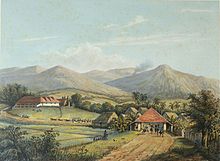
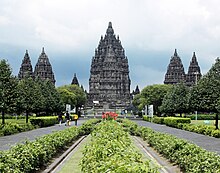




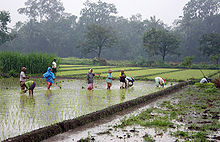

0 komentar:
Posting Komentar